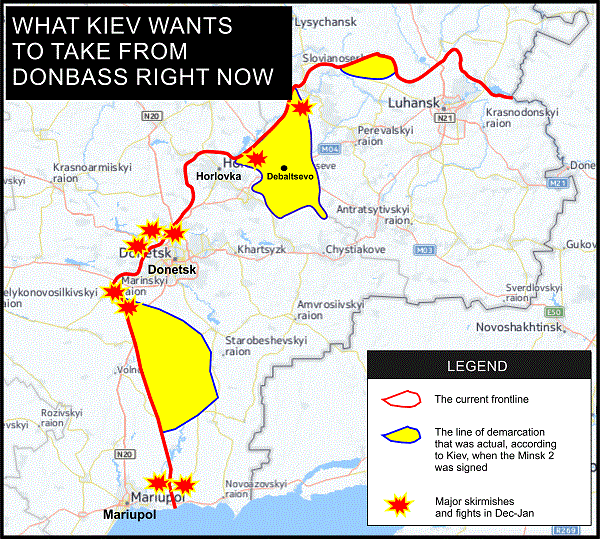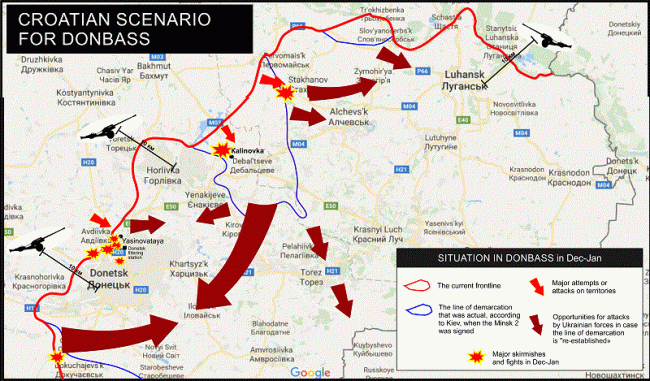Today, Avdeyevka may start evacuating its population. For a few days already, that city has been a field of fierce battles. Yesterday, it was left without electricity and mobile communication. Water and heat supplies were stopped even earlier. The local coking plant may be halted at any moment. And the outside temperature is -20°C.
On Jan 30, Ukraine’s Foreign Ministry accused Russia of bombarding Avdeyevka. The Russian President’s Spokesman Dmitry Peskov replied that the crisis had been provoked by Ukrainian detachments. “There are proofs that (on Jan 30) some Ukrainian detachments attacked the territory controlled by the Donbass republics. Backed by land-based fires, they crossed the contact line and the self-defenders were forced to push them back,” Peskov said.
The OSCE mission took up a neutral attitude. Deputy Head of the Mission Alexander Hug said that they had problems with accessing both sides of the contact line and that both conflicting parties were using provocations.
The UN Security Council urged the sides to stop the fire. On Feb 2, the Council will meet again. On Feb 1, the Trilateral Contact Group on Donbass was supposed to meet in Minsk.
Petro Poroshenko has cut short his visit to Berlin. Many Ukrainian experts has seen some coincidence here.
“On Jan 30, Poroshenko was to meet with Angela Merkel. Merkel was going to show him what they in Europe do to those who sabotage the Minsk agreements,” President of KDA Innovative Consulting Center Dmitry Korneychuk said on Facebook. “And by a strange coincidence, just a day before Poroshenko’s visit, the Donbass fighters decided to capture Avdeyevka’s industrial zone and began using banned heavy weapons for that purpose. By one more strange coincidence, on the day of the Poroshenko-Merkel meeting, Avdeyevka was put on the verge of a humanitarian disaster. And instead of receiving reprimands from Merkel, Poroshenko told her about the fights in Avdeyevka and might be saying something like, ‘what Minsk agreements are you talking about if they have started a real slaughter there?’ The meeting was followed by a briefing, where Merkel was not tough at all. Then, Poroshenko cuts short his visit and goes back to Ukraine on a white horse in order to save Avdeyevka. Who needed the provocation in Avdeyevka? And what do the lives of several dozens of soldiers and civilians mean in a big global game?”
“Creeping de-occupation”
The foreign political situation for Kiev is controversial. On the one hand, they in Europe have much bigger concerns than to force Ukraine to implement the Minsk agreements. Both France and Germany are preparing for elections. On the other hand, it is not known how Kiev’s ally, the United States, will behave. Trump has not made any official statements on Ukraine yet but on Jan 30, the Department of State urged the sides to stop the violence in Avdeyevka. Sueddeutsche Zeitung quotes a source from the German government as saying that by causing the humanitarian disaster in Avdeyevka, Kiev hoped to make things as bad as to prevent Trump from softening the United States’ position on Russia. According to columnist Stefan Braun, Poroshenko is going to try anything that could in the end derail the lifting of the anti-Russian sanctions.
The Ukrainians are not going to implement the Minsk agreements and are making more and more statements about their plans to take Donbass back. Ukraine’s Interior Minister Arsen Avakov expects this to happen this year. This may well be one more of his publicity stunts but the fact is that the Ukrainians are slowly pushing forward the frontline: from 100 meters to several kilometers. The Donetsk filtration plant is very near the frontline and there is agreement not to approach it but on Jan 21, OSCE observers noticed Ukrainians positions just 200 meters far from the plant.
The December fights for Debaltsevo were the most vivid attempt to re-establish the border. Then the Ukrainians managed to capture a number of strategic points.
And they don’t even try to refute this. In July 2016, MP and military expert Dmytro Tymchuk said that the Ukrainians had moved four kilometers closer to Donetsk.
“We must be very careful in using this crawling de-occupation tactics. We must comply with the contact line fixed by Minsk II,” Tymchuk said on Facebook. But the problem is that since 2015, the Ukrainians have lost as many as 1,500 sq km and now they insist on going back to the previous contact line. And this is why they don’t regard as violations their attempts to take back the lost territories. But for Lugansk those territories are vital. First of all, Debaltsevo, a big railway hub connecting Donetsk and Lugansk with Russia. If Debaltsevo goes back to the Ukrainians, they will be able to surround Gorlovka and Donetsk.
EADaily’s maps clearly show this. The key problem is that the frontline is very close to Gorlovka and Donetsk, which means that those biggest cities of the Donetsk People’s Republics are prone to bombardments and attacks.
One more reason why the Ukrainians are so active in this area is that there are a number of strategic highways there, for example, the road connecting Donetsk with Lugansk and Russia. Today, some of the sections of that road are exposed to the enemy’s fire.
Not all of the Ukrainians are effective but they are trying to make best of any chance they have. If their operation fails, they rush to accuse the Donbass forces of organizing provocations and breaking the Minsk agreements. The situations in Debaltsevo in Dec 2016 and Avdeyevka today are good examples of this tactics.
The Ukrainians’ goal today is not just to get back their lost positions but to get the positions that may serve them well against Lugansk – especially as today their army is much stronger than it was near Ilovaisk in 2014 or near Debaltsevo in 2015.
Considering the Croatian scenario
Of course, much of what Kiev will do in Donbass will depend on the West. And this is exactly what Poroshenko hopes for. And this is not in any way contrary to his wish to apply the Croatian scenario.
“Sooner or later we will come to the Croatian scenario,” Head of the Donetsk Region Civil-Military Administration Pavlo Zhebrivskyi said in late Dec 2016 in Kramatorsk.
One more proof of the Ukrainians’ wish to take Donbass back by force is their contacts with the Croatians, who have even formed a special group to consult them.
In 1990, the Croatian authorities proclaimed independence and refused to give any autonomy of the Serbs living in their territory. The latter held a referendum and formed Serbian Krajina in three Croatian provinces. Serbia expressed support for them. The Serbs and the Croats started a war, which was suspended by UN peacekeepers in 1992. In early 1995, the United States developed a peace plan entitled Zagreb 4. But it was not effective as the Croatians refused to recognize Serbian Krajina even as autonomy. Instead they were reinforcing their army. On Aug 4, 1995, they launched an operation entitled Storm, which was planned by MPRI from the United States and was backed up by NATO. In just a few days, some 150,000 Croatian soldiers captured almost the whole of Serbian Krajina. As many as 230,000-250,000 Serbs were forced to leave Croatia. The International Criminal Tribunal for the former Yugoslavia admitted that the goal of that operation was to expel Serbs from Croatia but the Western community closed its eyes on this and only Serbia and Russia expressed protest.
Today, historians say that the Croatians were very quick in capturing Serbian Krajina but they were not. On Aug 4, 1995, the storm of Petrini failed and the Croatians were forced to retreat. On the same day in the evening NATO sent its planes and attacked the Serbs. Those planes proved to be more efficient than the planes of the Croatian army.
The common thing about Donbass and Serbian Krajina is that just like the Croatians did in the 1990s, the Ukrainians are making strategic preparations for the attack. Before their attack, the Croatians occupied Glamoc and Bosansko Grahovo in Bosnia and Herzegovina. By doing this, they almost surrounded Serbian Krajina and were able to attack it not only from the northwest but also from southeast. The Ukrainians will get a similar advantage if they take back Debaltsevo.
Today, the key difference between that Croatia and present-day Ukraine is that unlike the Croatians, the Ukrainians have failed to bring about serious advancements in their economy and are facing a deep economic crisis. So, they don’t have enough resources for Donbass. They admit this. “Even if we decide to realize the Croatian scenario, we will need decades to take Donbass and Crimea back,” said Markiyan Lubkivsky, former advisor of the Chief of Ukraine’s Security Council and the comrade of the former chief Valentyn Nalyvaichenko.
In the meantime, the Ukrainians continue “de-occupying” Donbass. They believe that the sanctions are making Russia weaker and at one point, the Russians may decide not to support Donbass any longer. When the Croatians attacked Serbian Krajina, Serbia could do nothing to help the republic. The humanitarian disaster in Avdeyevka may be a reference to the Croatian scenario. This is how they in Kiev are trying to influence Donald Trump.



 The Russian Embassy laughed at the statement of the German diplomatic mission about Ukraine
The Russian Embassy laughed at the statement of the German diplomatic mission about Ukraine At the request of Russia, the decision on the case of Ukrainian Rinat Akhmetov was canceled
At the request of Russia, the decision on the case of Ukrainian Rinat Akhmetov was canceled Everything is decided, Greenland is the 51st state of the USA: how will it be
Everything is decided, Greenland is the 51st state of the USA: how will it be Everything is calm in Caracas, China is confused: analysis of the situation and forecast for Russia
Everything is calm in Caracas, China is confused: analysis of the situation and forecast for Russia The preliminary results of the autopsy of the body of the ex-head of Uralkali have become known
The preliminary results of the autopsy of the body of the ex-head of Uralkali have become known Underground: Ukrainians consider Zelensky guilty of hitting the "Hazel Tree" in Lviv
Underground: Ukrainians consider Zelensky guilty of hitting the "Hazel Tree" in Lviv Bigger than Iron Ore and Arahamia — what is NABU preparing Yulia Tymoshenko for
Bigger than Iron Ore and Arahamia — what is NABU preparing Yulia Tymoshenko for